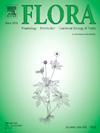Drought priming enhances photosynthesis and growth of the ephemeral plant Erodium oxyrhinchum
IF 1.8
4区 生物学
Q3 ECOLOGY
引用次数: 0
Abstract
The increasing frequency and intensity of drought events due to climate change pose significant challenges to plant growth. However, it remains unclear whether drought priming during early growth stages can enhance plant resilience and mitigate the adverse effects of severe drought stress. To address this, we conducted an experiment on the desert ephemeral plant Erodium oxyrhinchum to examine its photosynthesis and growth responses to drought priming in the Gurbantunggut Desert, China. The field experiment included two treatments: (1) drought priming applied twice at the seedling stage followed by severe drought stress at the reproductive stage, and (2) adequate irrigation at the seedling stage followed by severe drought stress at the reproductive stage. Our results showed that drought priming significantly reduced stomatal conductance during the full leaf expansion stage, but enhanced net photosynthesis at the initial flowering stage. Compared to the control, drought-primed plants exhibited lower intercellular CO₂ concentrations at both the full leaf expansion and initial flowering stages, along with increased stomatal limitation and intrinsic water use efficiency. Additionally, drought priming significantly elevated superoxide dismutase activity and soluble sugar accumulation at the initial flowering stage. Throughout the plant’s life cycle, free proline and soluble sugar concentration initially increased and then declined, with both superoxide dismutase activity and soluble sugar concentration remaining significantly higher at the initial flowering stage under drought priming. These findings indicate that drought priming enhances stress tolerance by activating protective metabolic mechanisms, reducing transpiration, and improving both water use and photosynthetic efficiency. Finally, drought-primed plants not only exhibited greater resilience to severe drought stress but also demonstrated compensatory growth, leading to increased individual total biomass and reproductive output. Therefore, drought priming may serve as a promising strategy for sustaining plant growth under extreme drought conditions and offers valuable insights for vegetation restoration in arid and semi-arid ecosystems.
干旱胁迫促进了短命植物黄牡丹的光合作用和生长
由于气候变化,干旱事件的频率和强度不断增加,对植物生长构成了重大挑战。然而,尚不清楚在生长早期的干旱诱导是否能提高植物的抗旱能力,减轻严重干旱胁迫的不利影响。为了解决这一问题,我们在古尔班通古特沙漠对沙漠短生植物黄花Erodium oxyrhinchum进行了试验,研究了其光合作用和生长对干旱的响应。田间试验包括两个处理:(1)苗期灌水2次,生殖期严重干旱胁迫;(2)苗期充分灌溉,生殖期严重干旱胁迫。结果表明,干旱胁迫显著降低了全叶膨大期的气孔导度,但提高了开花初期的净光合作用。与对照相比,干旱胁迫下植株在叶片全张期和开花初期细胞间CO 2浓度均较低,气孔限制和水分利用效率均有所提高。此外,干旱胁迫显著提高了开花初期的超氧化物歧化酶活性和可溶性糖积累。在植株的整个生命周期中,游离脯氨酸和可溶性糖浓度呈先上升后下降的趋势,在干旱胁迫下,超氧化物歧化酶活性和可溶性糖浓度在开花初期均保持较高水平。这些结果表明,干旱胁迫通过激活保护性代谢机制、减少蒸腾作用、提高水分利用和光合效率来增强抗逆性。最后,干旱胁迫下的植物不仅表现出更强的抗旱能力,而且表现出代偿性生长,导致个体总生物量和生殖产量增加。因此,干旱启动可能是在极端干旱条件下维持植物生长的一种有希望的策略,并为干旱和半干旱生态系统的植被恢复提供了有价值的见解。
本文章由计算机程序翻译,如有差异,请以英文原文为准。
求助全文
约1分钟内获得全文
求助全文
来源期刊

Flora
生物-植物科学
CiteScore
3.30
自引率
10.50%
发文量
130
审稿时长
54 days
期刊介绍:
FLORA publishes original contributions and review articles on plant structure (morphology and anatomy), plant distribution (incl. phylogeography) and plant functional ecology (ecophysiology, population ecology and population genetics, organismic interactions, community ecology, ecosystem ecology). Manuscripts (both original and review articles) on a single topic can be compiled in Special Issues, for which suggestions are welcome.
FLORA, the scientific botanical journal with the longest uninterrupted publication sequence (since 1818), considers manuscripts in the above areas which appeal a broad scientific and international readership. Manuscripts focused on floristics and vegetation science will only be considered if they exceed the pure descriptive approach and have relevance for interpreting plant morphology, distribution or ecology. Manuscripts whose content is restricted to purely systematic and nomenclature matters, to geobotanical aspects of only local interest, to pure applications in agri-, horti- or silviculture and pharmacology, and experimental studies dealing exclusively with investigations at the cellular and subcellular level will not be accepted. Manuscripts dealing with comparative and evolutionary aspects of morphology, anatomy and development are welcome.
 求助内容:
求助内容: 应助结果提醒方式:
应助结果提醒方式:


